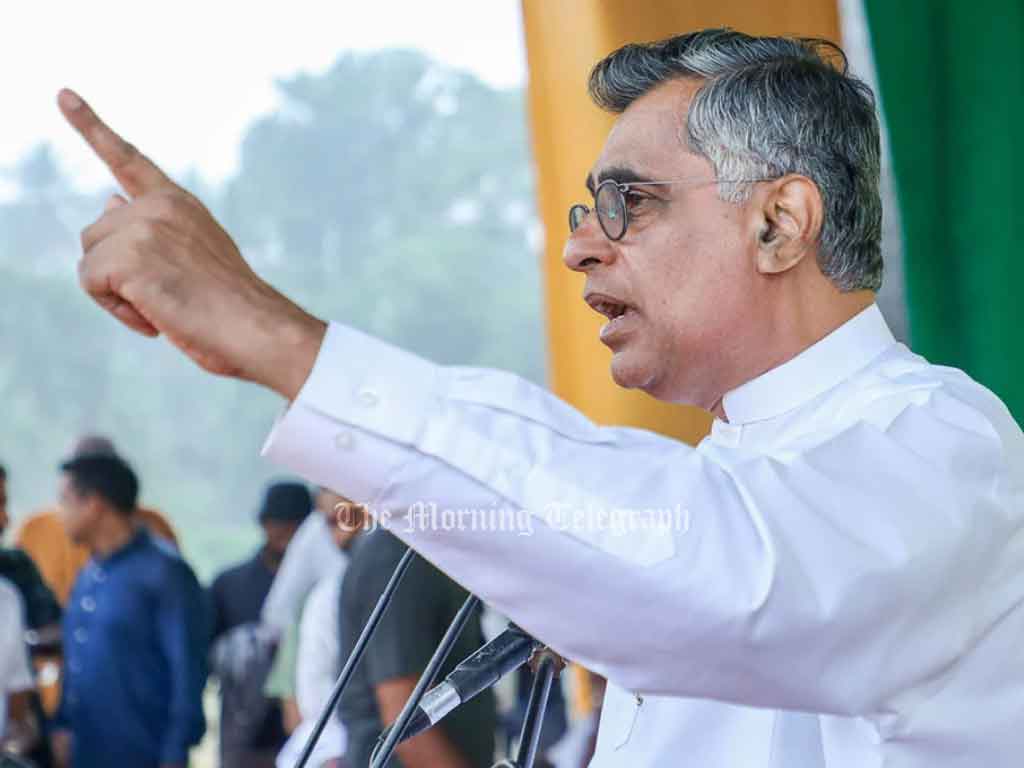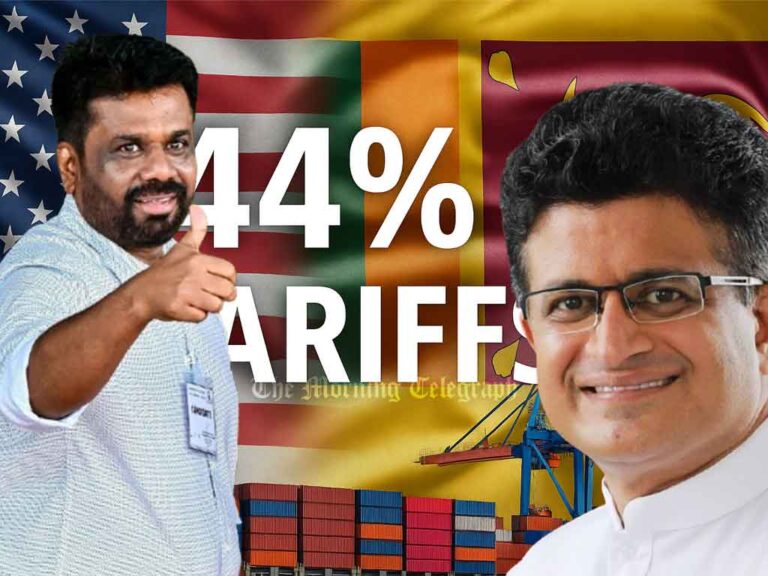
Although attempts were made to place the blame for the island-wide power outage that occurred on February 9th on the Lakvijaya Power Plant, United Republic Front leader Patali Champika Ranawaka alleged at a media briefing that the root cause was a fault at the Victoria Power Plant—and that the incident was an attempt to undermine the promotion of green energy.
At this media briefing, titled “The Real Cause of the Power Outage That Was Designed to Be Covered Up,” Mr. Ranawaka further commented as follows:
“On February 9th, at around 11:13 p.m., there was a nationwide power outage. The Ceylon Electricity Board (CEB) said the next day that it was due to an incident in Panadura. The Minister said it was caused by a monkey. However, the CEB’s initial report claimed that the countrywide outage was caused by the Lakvijaya coal-fired power plant in Puttalam.
However, I would like to point out that a detailed report issued by the CEB about a month later has since been suppressed. According to that report, the main reason for the power outage was not an imbalance in the absorption of solar and wind power into the system.
Although it was initially stated that the outage was caused by an imbalance resulting from solar and wind power, the most important point is that, according to the report, the Victoria or Kotmale reservoirs are normally used to manage such crises. At the time of the incident, a fault occurred at Victoria—or more precisely, the Victoria Power Plant tripped, according to the CEB report. It was after Victoria tripped that the Lakvijaya power plant in Puttalam followed suit.”
He said that a report issued by the Victoria Power Plant management supports this claim, and that it contradicts the report produced by the CEB’s System Management Division.
According to the Victoria report, the second unit of the plant tripped at 11:13:59 p.m., and the third unit at 11:14:02 p.m. All three units of the Lakvijaya Power Plant tripped afterward—at 11:14:04, 11:14:08, and 11:14:08. Accordingly, it is very clear that although the Lakvijaya plant was affected, Victoria actually tripped first.
Stressing that the Ministry of Power and Energy should take full responsibility for the incident, Mr. Ranawaka alleged that engineers had been warning of a potential breakdown since last November, and especially on February 8th. Despite these warnings, the political leadership—including the Minister, Chairman, and Vice Chairman—had ignored them.
He stated that due to this breakdown, the CEB suffered an energy loss of approximately 10 gigawatt hours and a direct financial loss of Rs. 8,463 million (846 crores), and that the loss to the country’s economy could be several times greater.
Mr. Ranawaka further alleged that the incident is being used to suppress green energy sources such as solar, wind, and small hydropower. “Using this, the Ceylon Electricity Board has now launched a program that diminishes support for green energy. As a result, the amount spent by the CEB on thermal power generation over the last two months (February and March) has increased by Rs. 14 billion (140 million).”
He predicted that the government is preparing to increase electricity tariffs in June, following the local government elections, to recover these losses—placing a burden on 7.5 million consumers.
Mr. Ranawaka demanded an immediate investigation by the COPE Committee of Parliament regarding the blackout, an audit by the Auditor General, and that the Public Utilities Commission of Sri Lanka (PUCSL) hold a public tribunal on what he termed “economic crimes.”
He also revealed that a cabinet paper was tabled on March 18th proposing a reduction in solar power tariffs—Rs. 14.46 for power plants above 1 MW and Rs. 19.61 for domestic rooftop systems. He claimed that this move is an attempt to completely destroy the solar power industry, especially when electricity generated from thermal power plants costs Rs. 40–50 per unit.
In a context where 2,670 gigawatt hours of green energy were generated last year (2024), saving the country $260 million (Rs. 78 billion), Mr. Ranawaka added that a “coal and oil mafia” is trying to reverse this progress, and that the advisors appointed following the current President’s rise to office are responsible.
“The government should immediately reverse these decisions and take steps to promote green energy. Otherwise, we will not hesitate to reveal even more subtle issues in the future,” emphasized the leader of the United Republic Front.
Here, Mr. Patali Champika Ranawaka responded to questions from journalists:
Question: Will there be any specific harm to the consumer from limiting solar power?
Answer: Yes, it’s possible that consumers will receive less. What is happening now? They are cutting the energy that we are already generating. At the same time, demand is very high due to the heat and the festive season. So where is this electricity coming from? From oil and coal. And who ends up paying the price? The consumers. That is what I pointed out. In February and March, the generation cost from thermal power plants increased by Rs. 14 billion.
Monkey Management Plans
Question: There are no results from the monkey census yet. Is there a story that these monkeys are being collected and released onto Randenigala Island?
Answer: Yes, we asked about that. Why is this census being done? What’s the expected outcome? Now it seems that only the monkeys in the Kandy district—specifically, the constituency of our Agriculture Minister Mr. Lalkantha—are being considered for relocation to Randenigala.
In fact, during my tenure as Environment Minister, I proposed a similar plan. I asked: has this ever been implemented successfully anywhere? No one could point to a place. So I said, let’s try a small-scale experiment. Let’s do a test and evaluate whether it works. Similar plans were made for elephants. We built the ‘Gaja Mithuro’ elephant fence on a large scale, but first, we did small trials.
I remember we once caught monkeys in Ratmalana and released them into forests in the Avissawella area. But the experience was disappointing. On one hand, money was spent. On the other, the monkey population remained uncontrolled. So, without learning from our past efforts, implementing this nationwide will be a massive waste.
The money spent on this monkey census is also being wasted—evidenced by the fact that we still haven’t seen any results. That too is a misuse of national funds. If the results can’t be released, those responsible should be charged under the Public Property Act. Spending public money on projects that have no outcome is a betrayal of public trust. Courts have already made rulings on such matters.
Ministers are entrusted with efficiently delivering public services for the greater good—not for trial-and-error pet projects. We shouldn’t waste public money on guesswork. From our previous experience, we know it doesn’t work. So why repeat it?
Before implementing new projects, we should look at past efforts and act accordingly. One of the main reasons for the rise in the monkey population is human-provided food.
Monkeys don’t usually consume natural food anymore. It’s the food produced by humans that has fueled their population boom. The same goes for other wild animals that damage forests. So, the best method is to stop people from feeding them. The key group here is farmers.
The government should empower farmers by giving them the necessary tools, support, and programs to protect their farmlands from these animals.
United Republic Front General Secretary Bandula Chandrasekara and Vice President Theekshana Gammanpila also participated in the media conference.




